All Items
27,382 items
|
Title
|
Images
|
Item Comment
|
Prefix
|
Number
|
In set
|
Set
|
Set Comment
|
Type
|
Artist
|
Author
|
Size
|
Topics
|
Set Covers
|
Reference
| |
|---|---|---|---|---|---|---|---|---|---|---|---|---|---|---|---|
| 24901 |

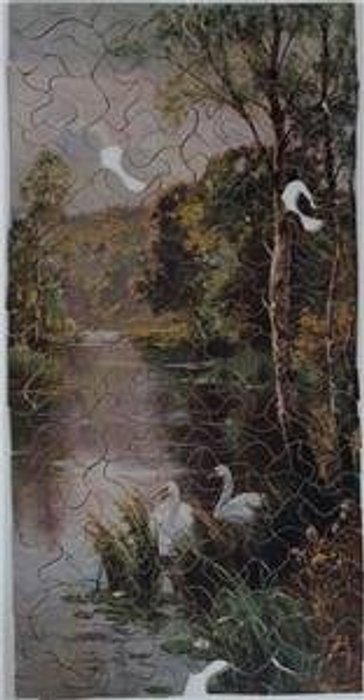
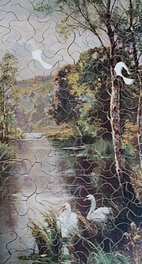



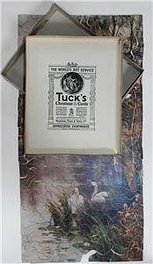

|
205 pieces, three pieces missing
|
|
|
|
FOR BIG FOLKS AND LITTLE FOLKS A FASCINATING PASTIME FOR EVERY HOUR, push-fit puzzles without figurals or whimsies
|
|
|
|
|
|
| |||
| 24902 |

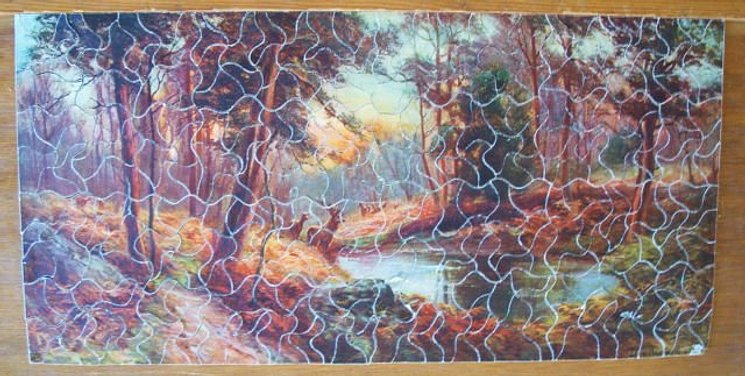


|
about 295 pieces, pushfit
|
|
|
|
FOR BIG FOLKS AND LITTLE FOLKS A FASCINATING PASTIME FOR EVERY HOUR, push-fit puzzles without figurals or whimsies
|
|
|
23 x 11.5 in.
|
|
|
| |||
| 24903 |
|
35 pieces
|
|
|
|
Zag-Zaw line of puzzles was first produced in 1909, all incorporate figurals or whimsies, sold in red or orange boxes with labels on the side or bottom of the box, most without guide pictures. Initially cut non-interlocking but by 1930's became more so. Puzzles have a different cuts so that the same image will come in several versions which means that missing pieces can not be taken from other puzzles with the same image. See also Bob Armstrong's website on old jigsaw puzzles
|
|
|
3.5 x 5.5 in.
|
|
|
| |||
| 24904 |
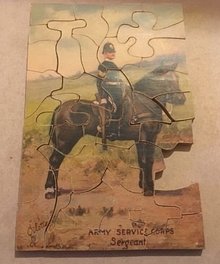
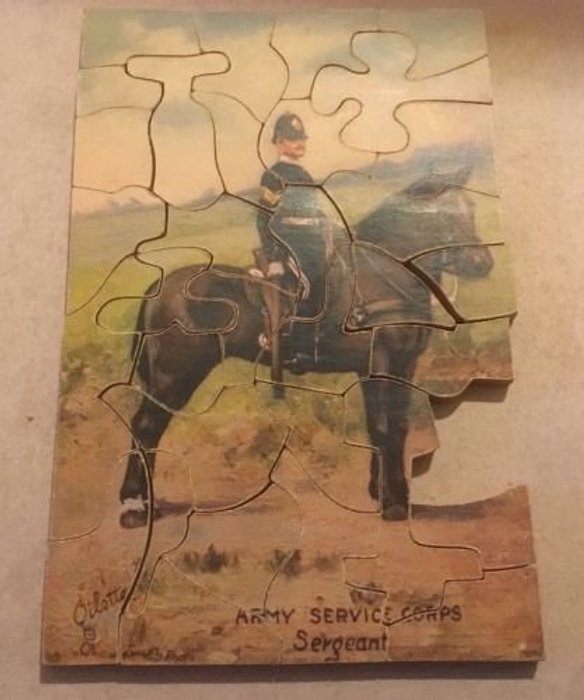
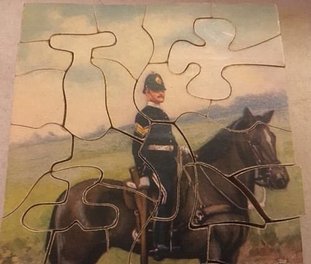

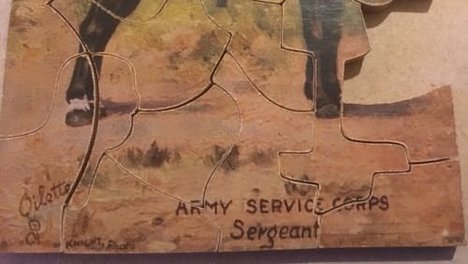
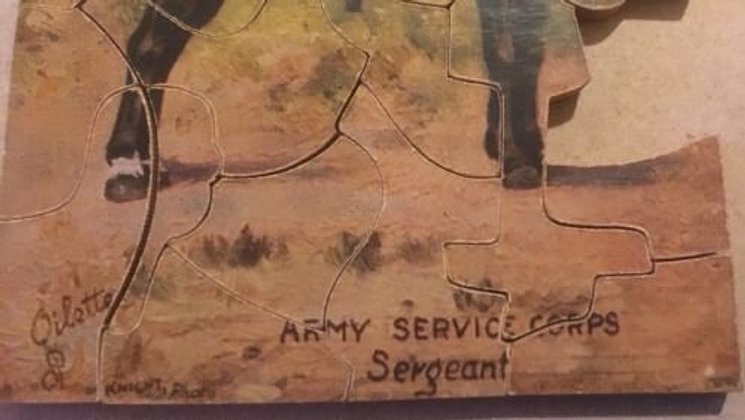
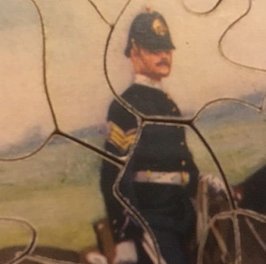
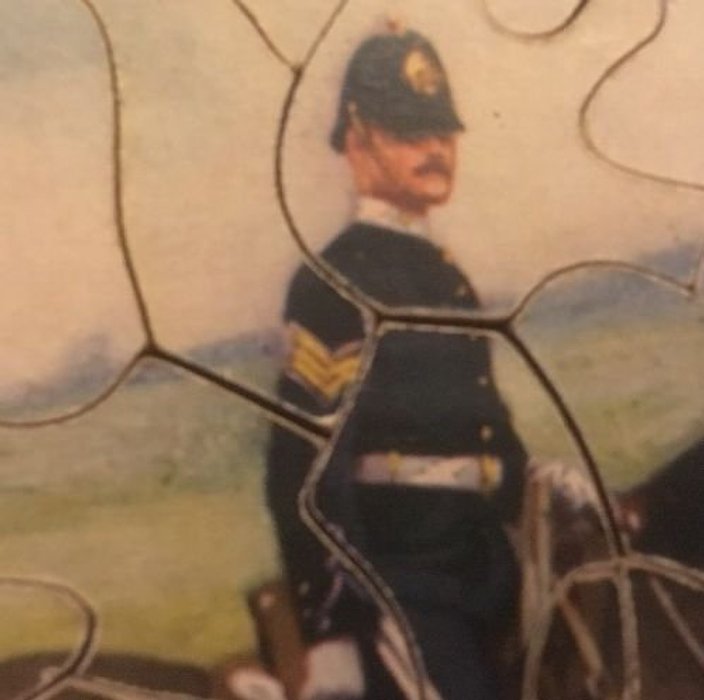
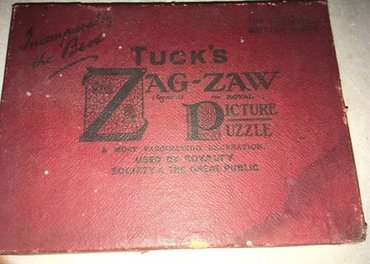
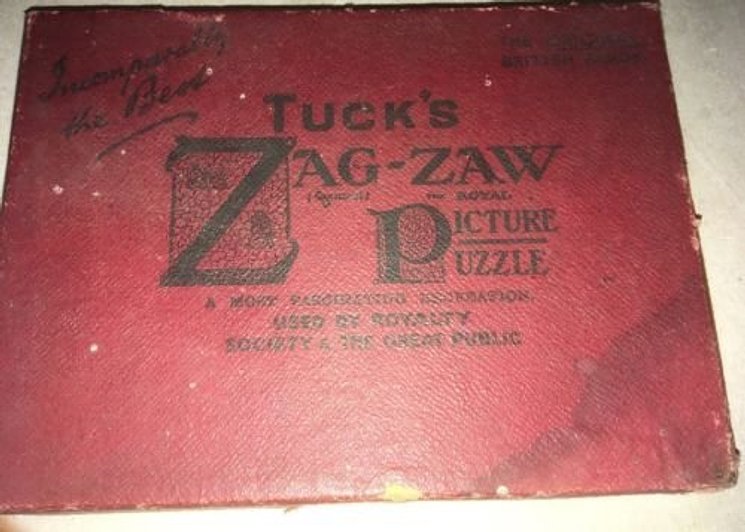
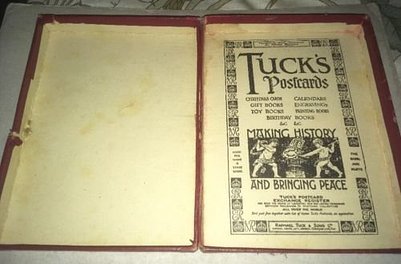
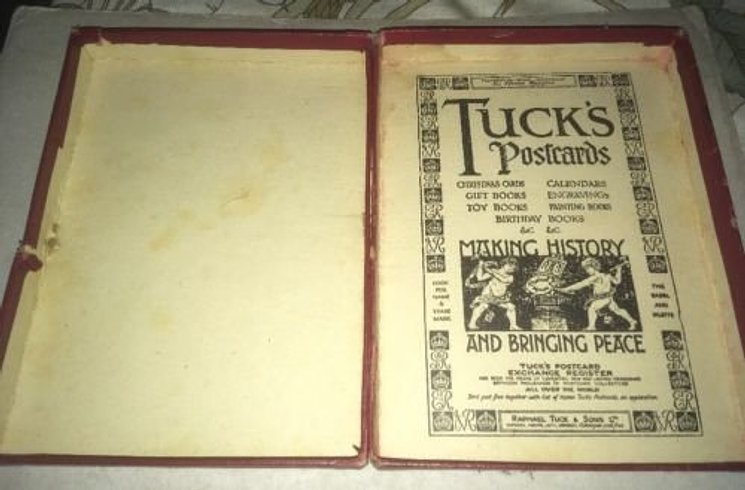
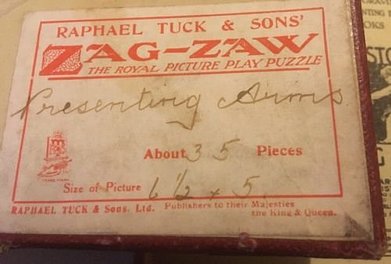
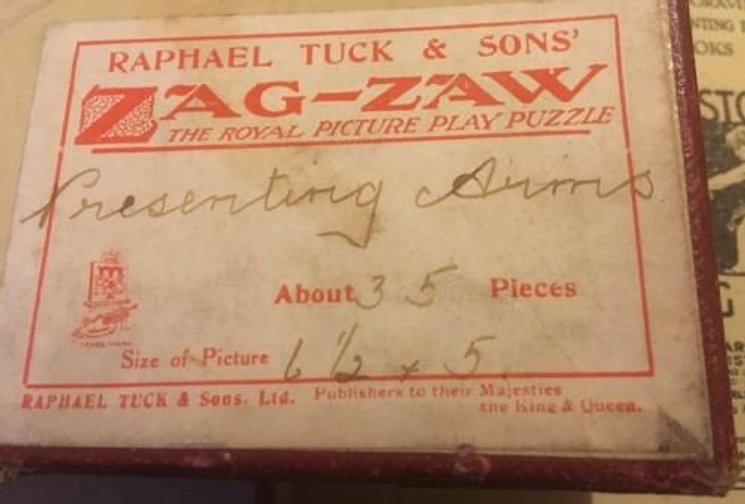
|
35 pieces, push fit
|
|
|
|
Zag-Zaw line of puzzles was first produced in 1909, all incorporate figurals or whimsies, sold in red or orange boxes with labels on the side or bottom of the box, most without guide pictures. Initially cut non-interlocking but by 1930's became more so. Puzzles have a different cuts so that the same image will come in several versions which means that missing pieces can not be taken from other puzzles with the same image. See also Bob Armstrong's website on old jigsaw puzzles
|
KNIGHT PHOTO
|
|
5 x 6.5 in.
|
|
| ||||
| 24905 |
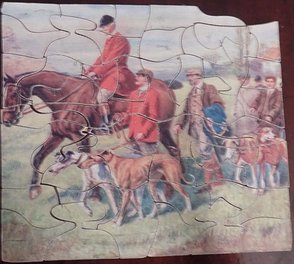
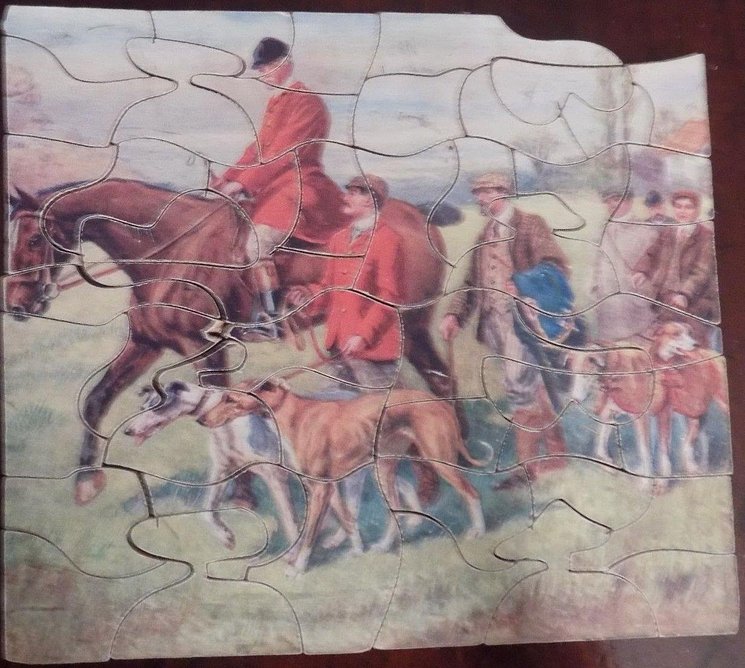
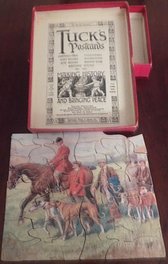


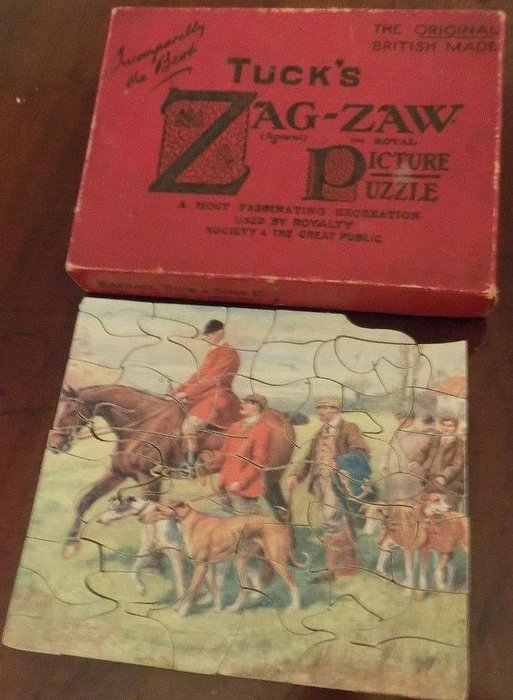
|
about 35 pieces, more info needed
|
|
|
|
Zag-Zaw line of puzzles was first produced in 1909, all incorporate figurals or whimsies, sold in red or orange boxes with labels on the side or bottom of the box, most without guide pictures. Initially cut non-interlocking but by 1930's became more so. Puzzles have a different cuts so that the same image will come in several versions which means that missing pieces can not be taken from other puzzles with the same image. See also Bob Armstrong's website on old jigsaw puzzles
|
|
|
6 x 5 inches
|
|
| ||||
| 24906 |


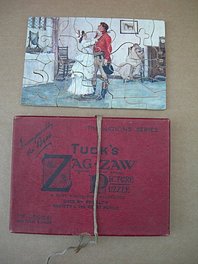
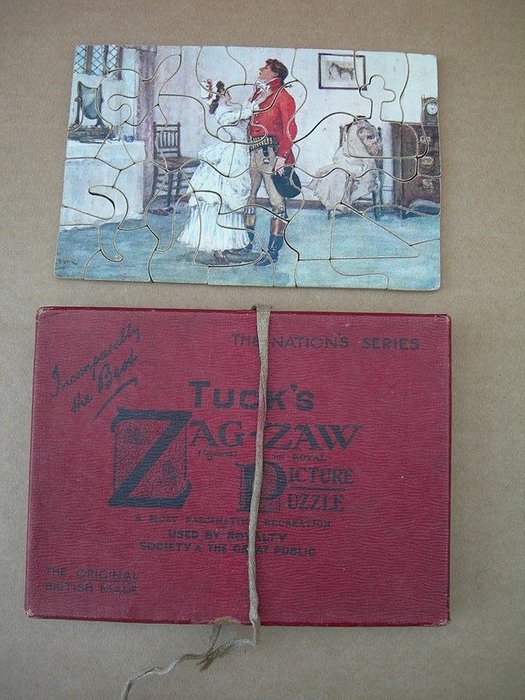
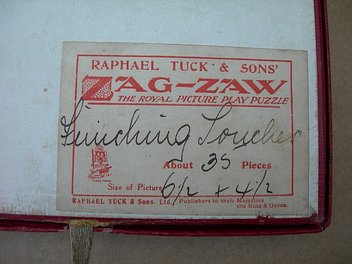

|
35 pieces
|
|
|
|
Zag-Zaw line of puzzles was first produced in 1909, all incorporate figurals or whimsies, sold in red or orange boxes with labels on the side or bottom of the box, most without guide pictures. Initially cut non-interlocking but by 1930's became more so. Puzzles have a different cuts so that the same image will come in several versions which means that missing pieces can not be taken from other puzzles with the same image. See also Bob Armstrong's website on old jigsaw puzzles
|
|
|
6.5 x 4.5 in
|
|
|
| |||
| 24907 |

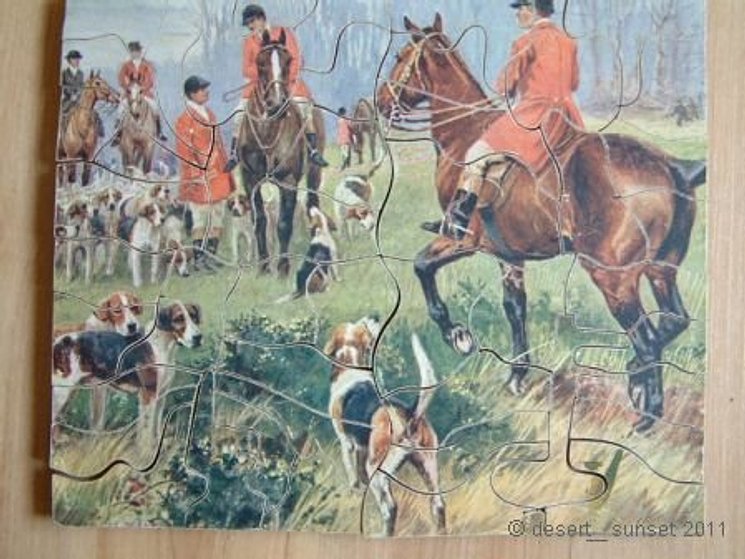
|
The picture is of a hunt scene and all the pieces are non-interlocking. 48 pieces.
|
|
|
|
Zag-Zaw line of puzzles was first produced in 1909, all incorporate figurals or whimsies, sold in red or orange boxes with labels on the side or bottom of the box, most without guide pictures. Initially cut non-interlocking but by 1930's became more so. Puzzles have a different cuts so that the same image will come in several versions which means that missing pieces can not be taken from other puzzles with the same image. See also Bob Armstrong's website on old jigsaw puzzles
|
|
|
6.5 x 5.5 in
|
|
|
| |||
| 24908 |
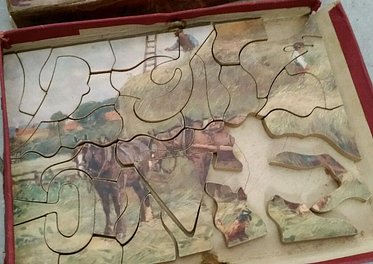
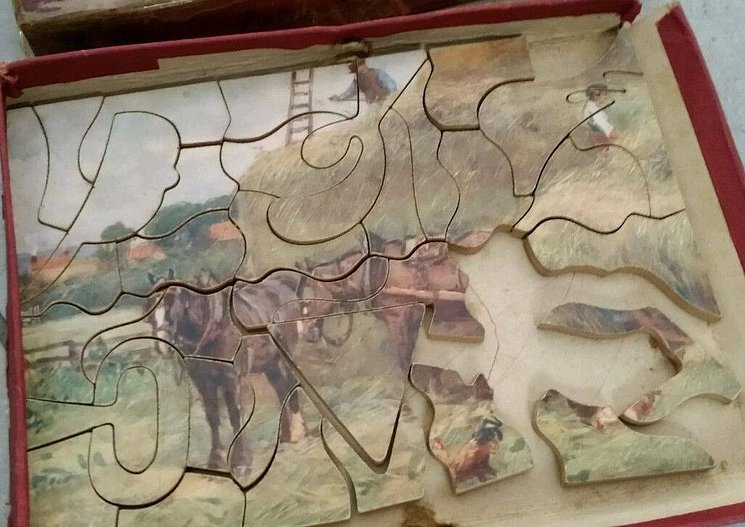
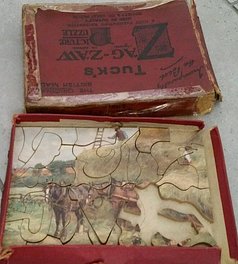
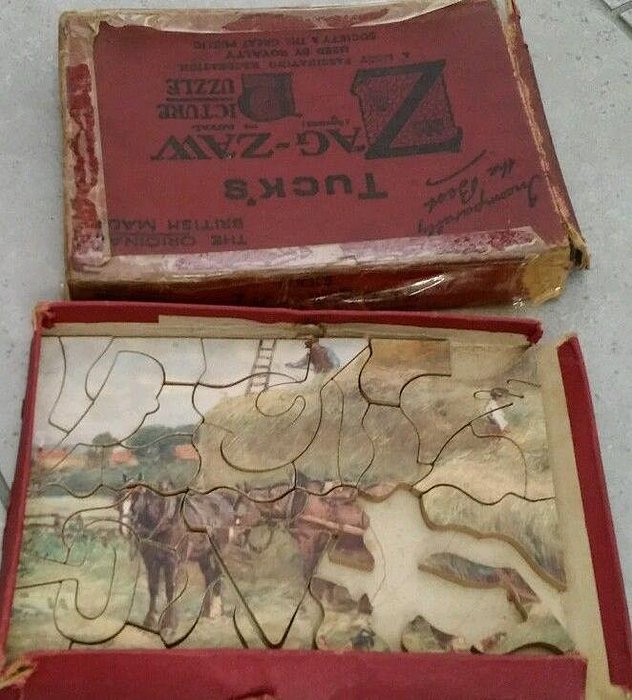
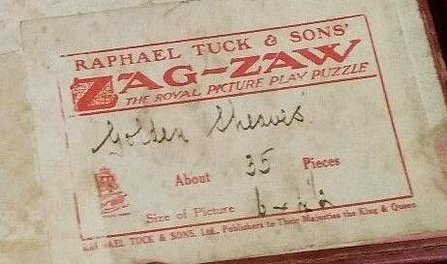
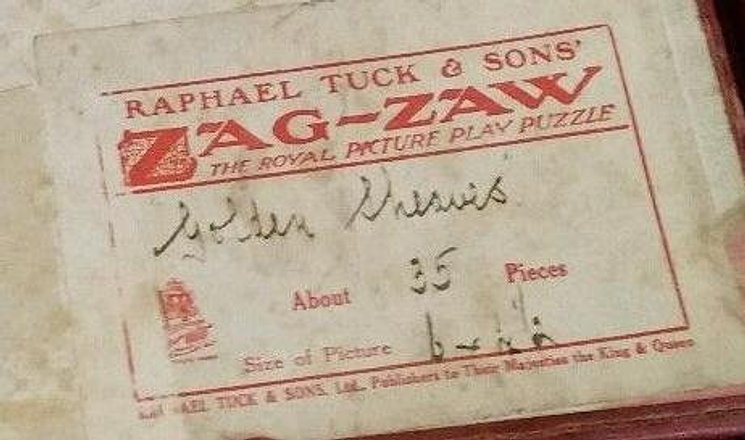
|
about 35 pieces
|
|
|
|
Zag-Zaw line of puzzles was first produced in 1909, all incorporate figurals or whimsies, sold in red or orange boxes with labels on the side or bottom of the box, most without guide pictures. Initially cut non-interlocking but by 1930's became more so. Puzzles have a different cuts so that the same image will come in several versions which means that missing pieces can not be taken from other puzzles with the same image. See also Bob Armstrong's website on old jigsaw puzzles
|
|
|
|
|
| ||||
| 24909 |
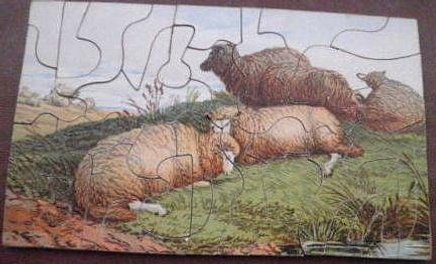
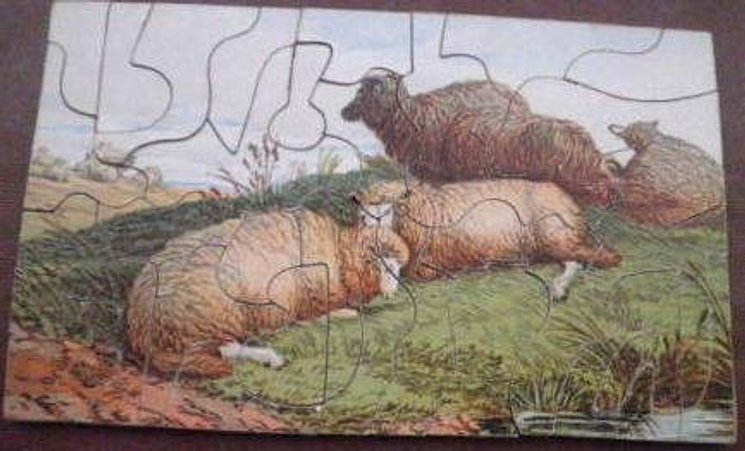
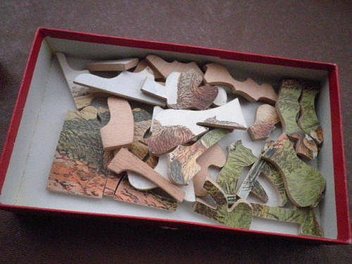

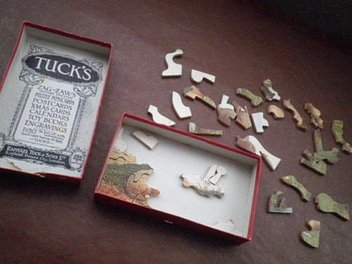
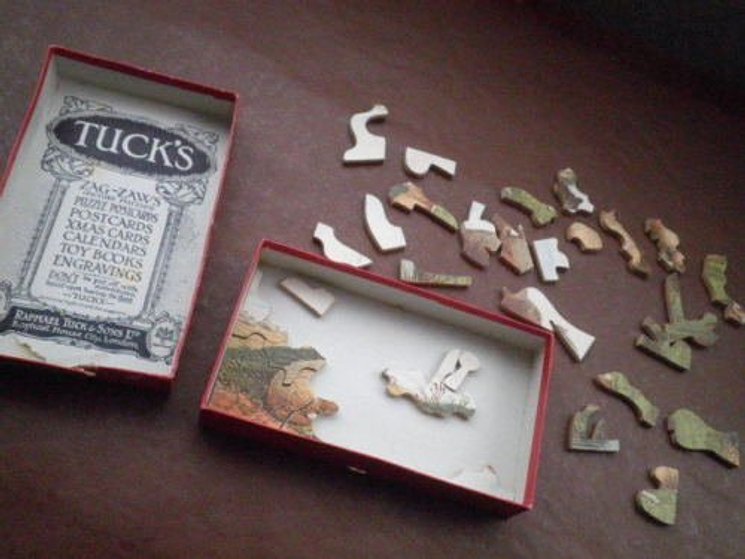
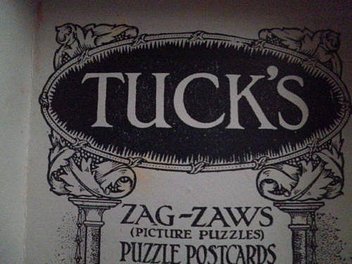
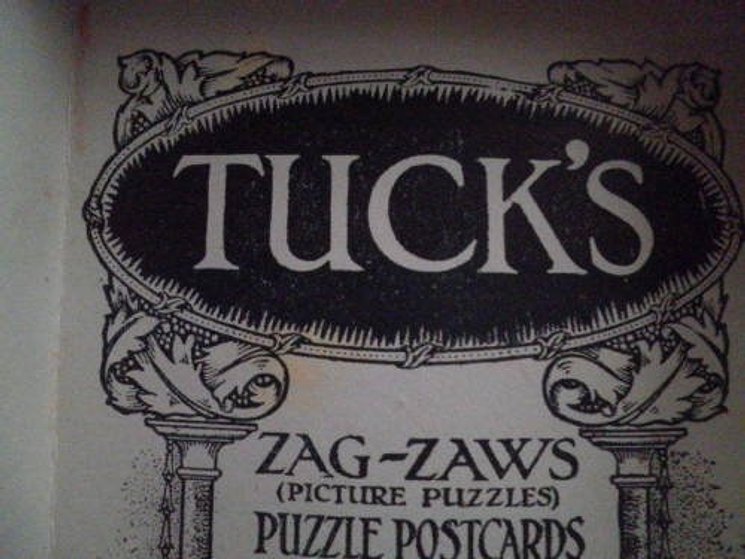
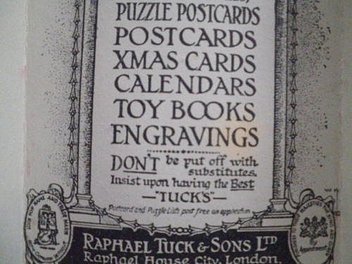
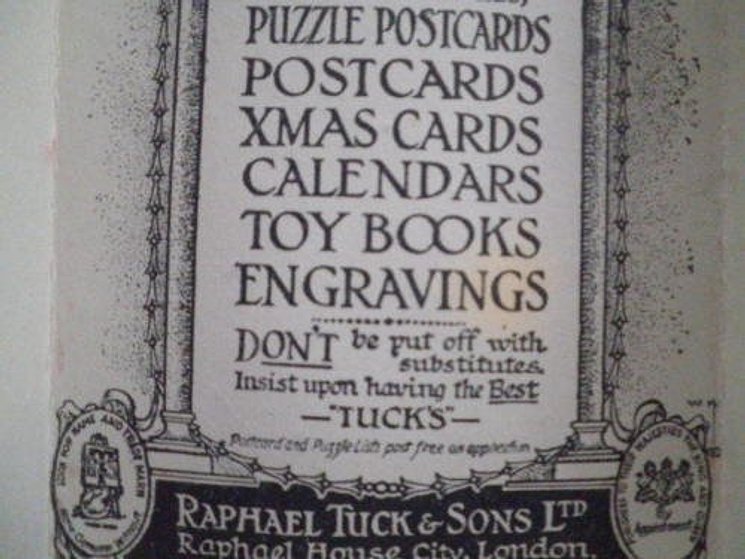
|
32 pieces, by "RAPHAEL TUCK &SONS Ltd. - LONDON" "PUBLISHERS TO THEIR MAJESTIES THE KING AND QUEEN"
|
|
|
|
Zag-Zaw line of puzzles was first produced in 1909, all incorporate figurals or whimsies, sold in red or orange boxes with labels on the side or bottom of the box, most without guide pictures. Initially cut non-interlocking but by 1930's became more so. Puzzles have a different cuts so that the same image will come in several versions which means that missing pieces can not be taken from other puzzles with the same image. See also Bob Armstrong's website on old jigsaw puzzles
|
F.L. HERRING SEUL ?
|
|
7 x 4 in.
|
|
| ||||
| 24910 |
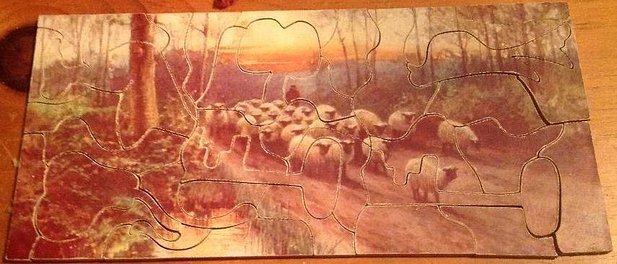
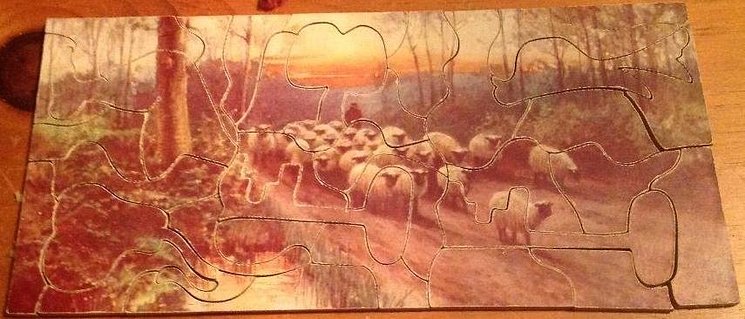
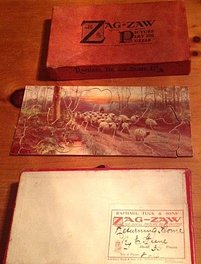

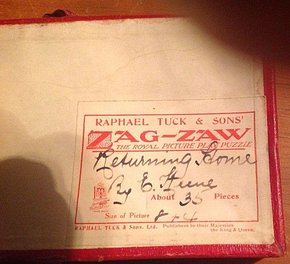
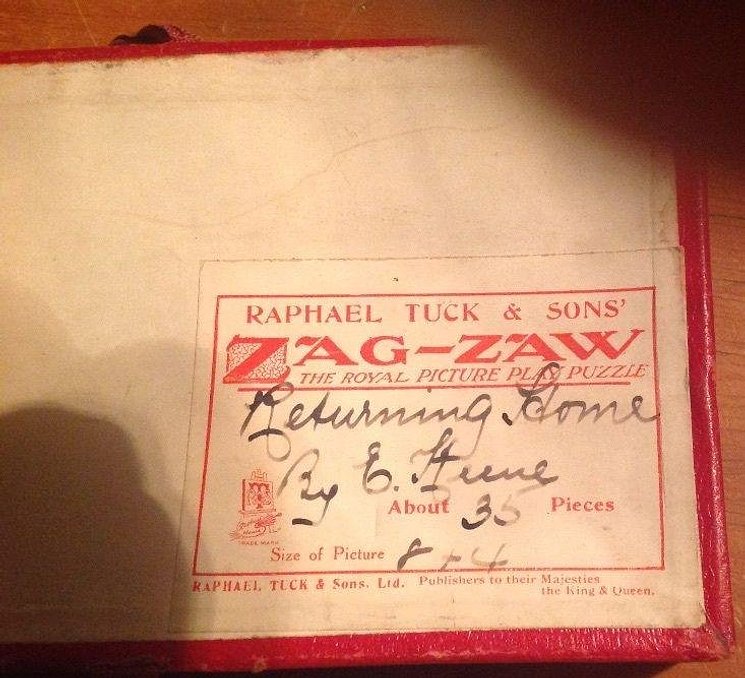
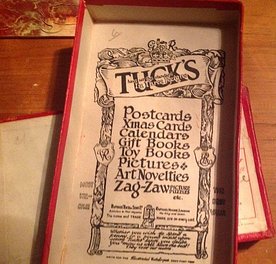
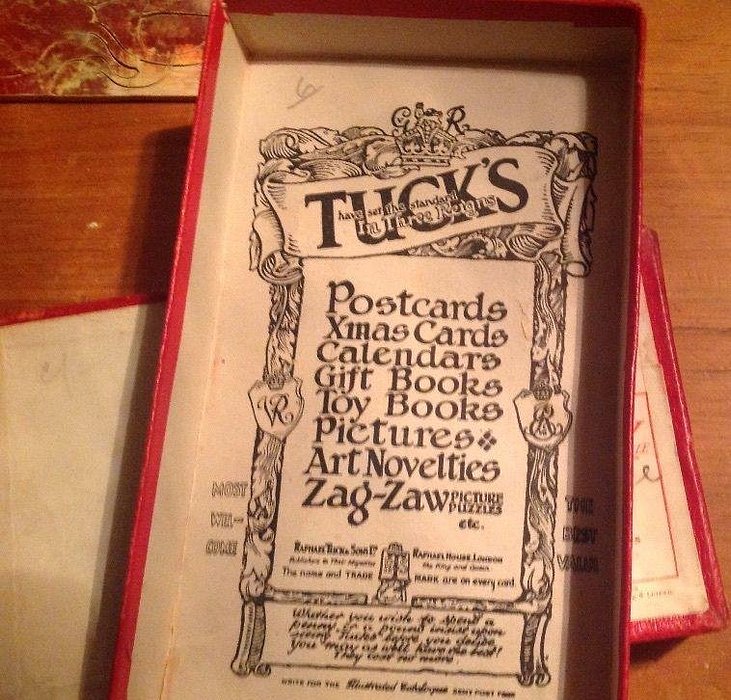
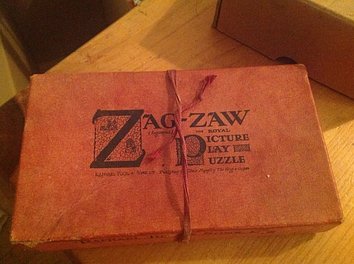
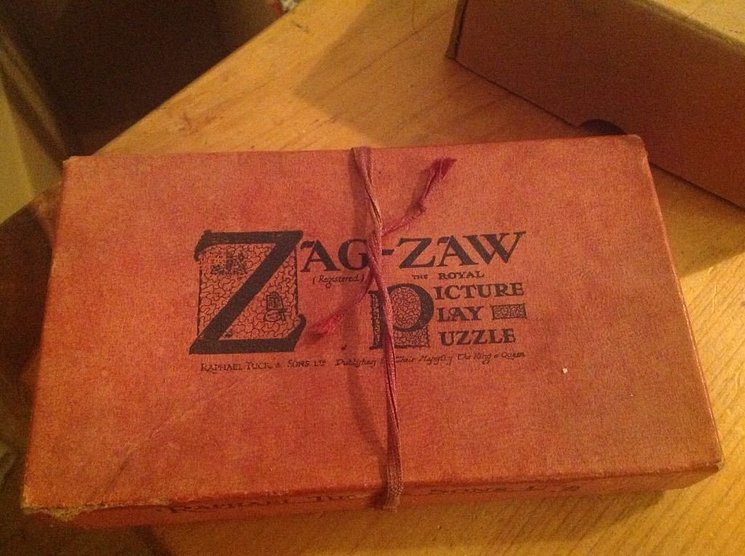
|
about 35 pieces,
|
|
|
|
Zag-Zaw line of puzzles was first produced in 1909, all incorporate figurals or whimsies, sold in red or orange boxes with labels on the side or bottom of the box, most without guide pictures. Initially cut non-interlocking but by 1930's became more so. Puzzles have a different cuts so that the same image will come in several versions which means that missing pieces can not be taken from other puzzles with the same image. See also Bob Armstrong's website on old jigsaw puzzles
|
E. HUNE to be confirmed
|
|
8 x 4 in.
|
|
|
| |||
| 24911 |
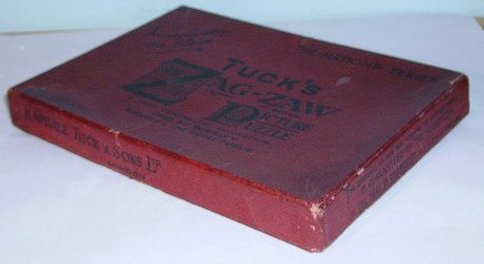

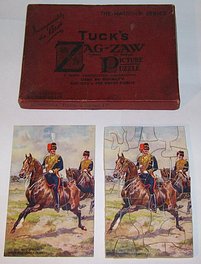
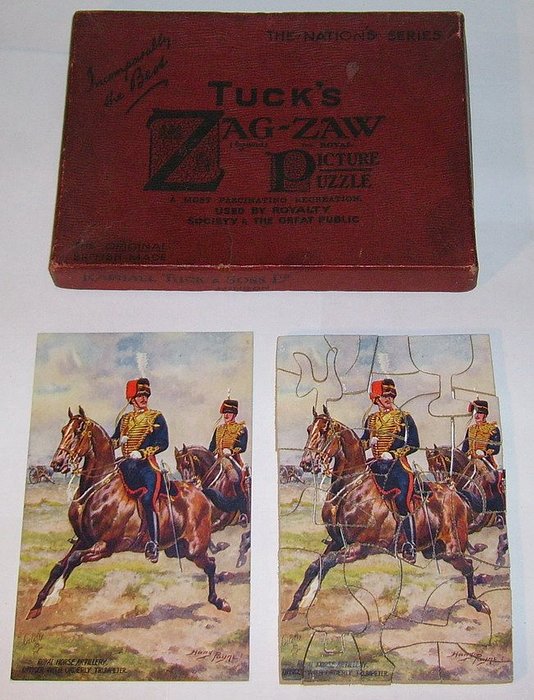
|
35 piece wooden (plywood) jigsaw puzzle
|
|
|
|
Zag-Zaw line of puzzles was first produced in 1909, all incorporate figurals or whimsies, sold in red or orange boxes with labels on the side or bottom of the box, most without guide pictures. Initially cut non-interlocking but by 1930's became more so. Puzzles have a different cuts so that the same image will come in several versions which means that missing pieces can not be taken from other puzzles with the same image. See also Bob Armstrong's website on old jigsaw puzzles
|
HARRY PAYNE
|
|
|
|
|
| |||
| 24912 |
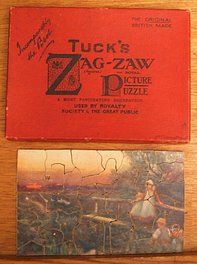
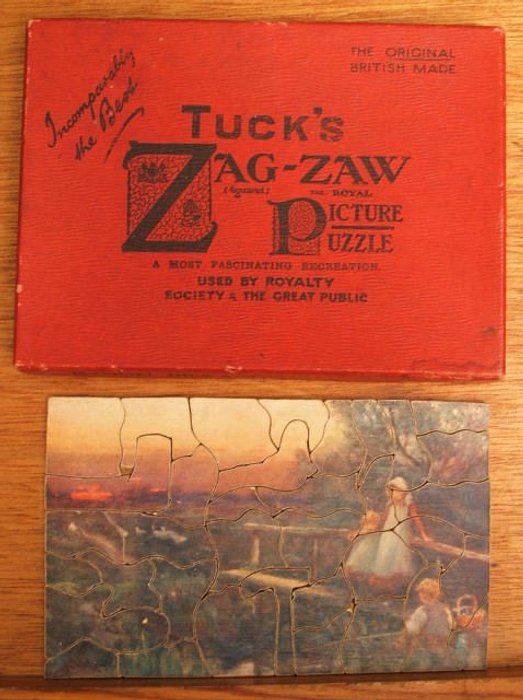
|
35 pieces, three whimsies
|
|
|
|
Zag-Zaw line of puzzles was first produced in 1909, all incorporate figurals or whimsies, sold in red or orange boxes with labels on the side or bottom of the box, most without guide pictures. Initially cut non-interlocking but by 1930's became more so. Puzzles have a different cuts so that the same image will come in several versions which means that missing pieces can not be taken from other puzzles with the same image. See also Bob Armstrong's website on old jigsaw puzzles
|
|
|
6 x 4 in.
|
|
|
| |||
| 24913 |
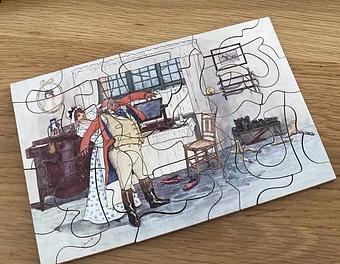
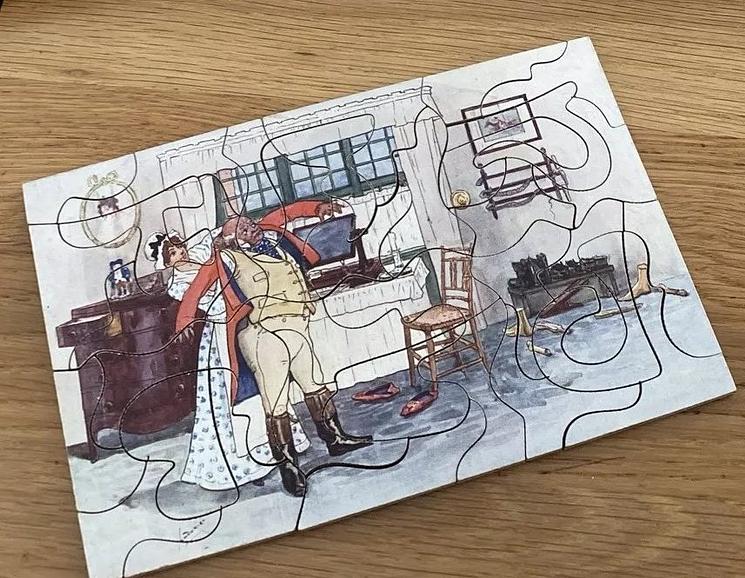
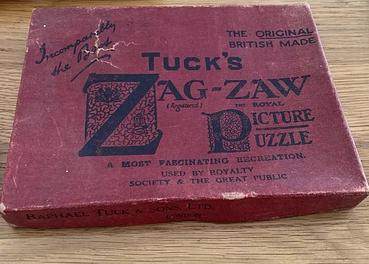

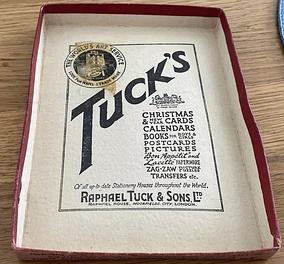
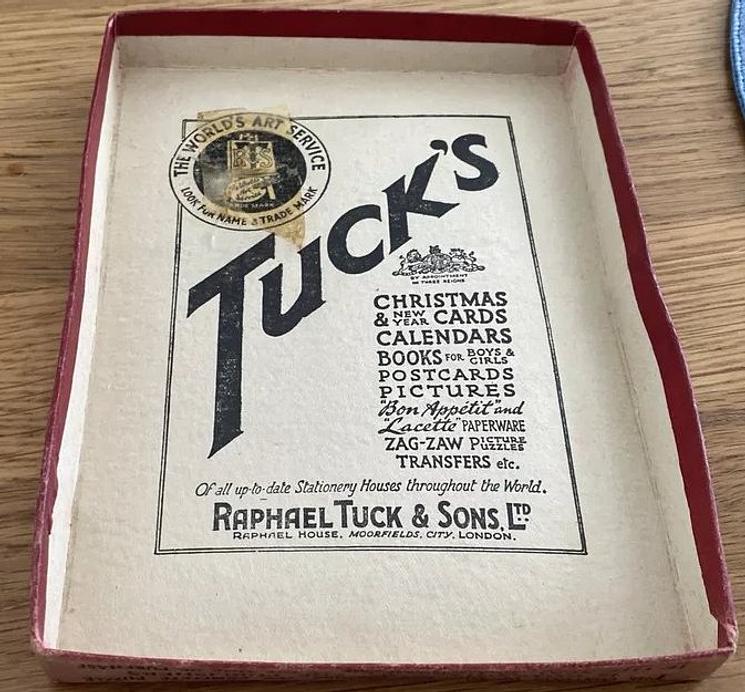
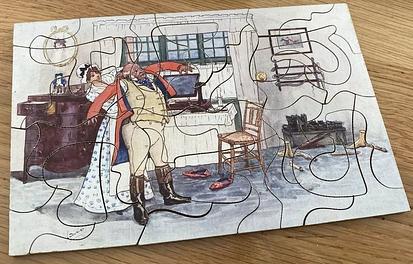
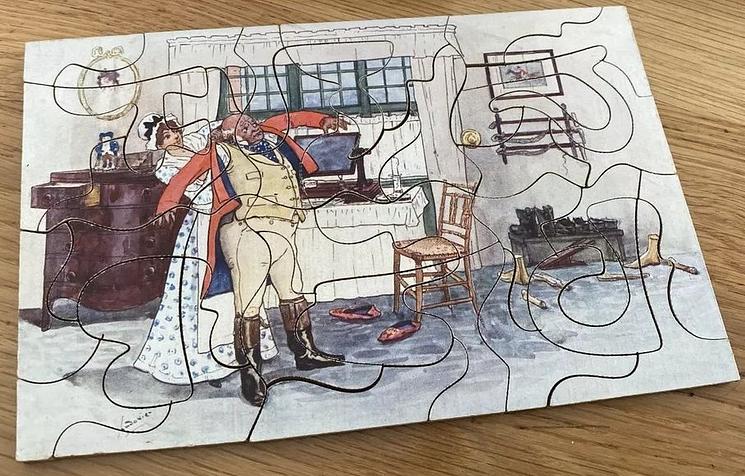
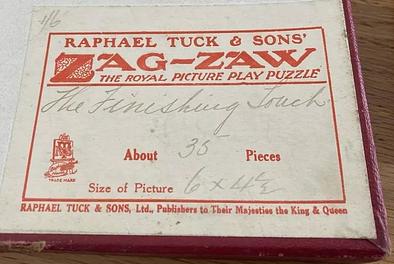

|
35 pieces
|
|
|
|
Zag-Zaw line of puzzles was first produced in 1909, all incorporate figurals or whimsies, sold in red or orange boxes with labels on the side or bottom of the box, most without guide pictures. Initially cut non-interlocking but by 1930's became more so. Puzzles have a different cuts so that the same image will come in several versions which means that missing pieces can not be taken from other puzzles with the same image. See also Bob Armstrong's website on old jigsaw puzzles
|
|
|
6.5 x 4.5 in
|
|
|
| |||
| 24914 |
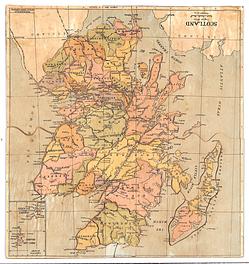
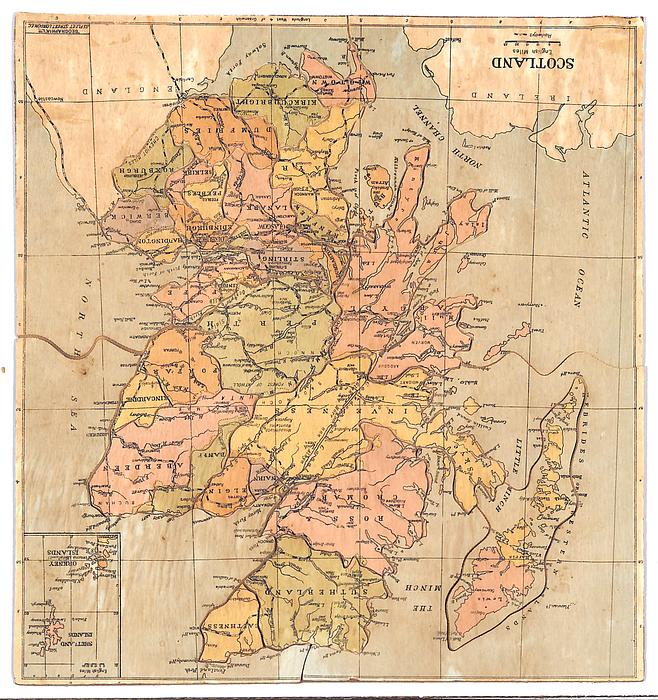
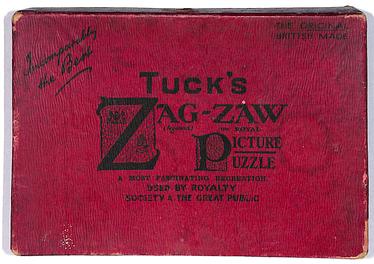

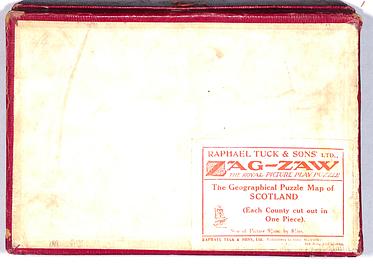

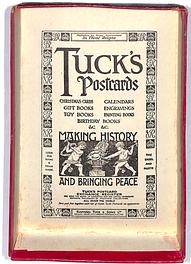
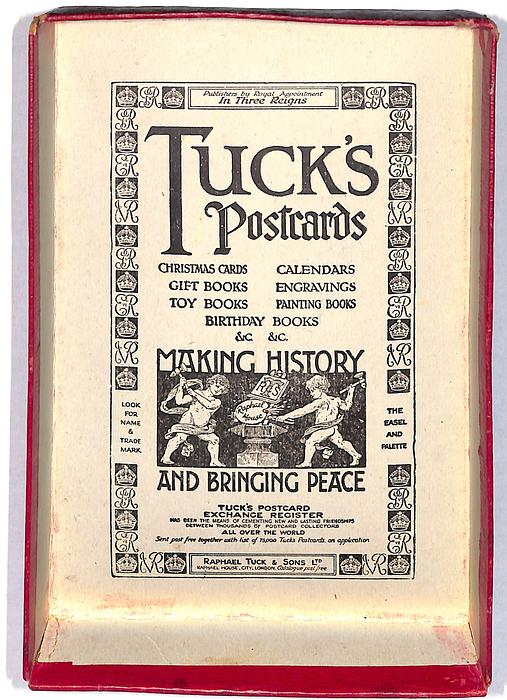
|
about 40 pieces, wooden, (EACH COUNTRY CUT OUT IN ONE PIECE), complete, with box, push fit style
|
|
|
|
Zag-Zaw line of puzzles was first produced in 1909, all incorporate figurals or whimsies, sold in red or orange boxes with labels on the side or bottom of the box, most without guide pictures. Initially cut non-interlocking but by 1930's became more so. Puzzles have a different cuts so that the same image will come in several versions which means that missing pieces can not be taken from other puzzles with the same image. See also Bob Armstrong's website on old jigsaw puzzles
|
|
|
8 1/2 x 9 in.
|
|
|
| |||
| 24915 |
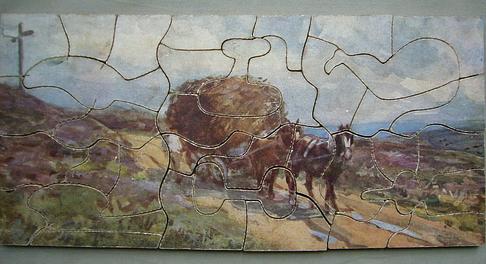
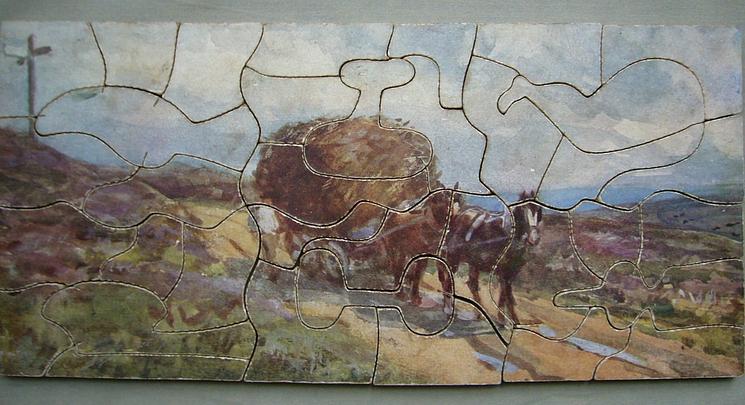
|
36 wooden pieces
|
|
|
|
Zag-Zaw line of puzzles was first produced in 1909, all incorporate figurals or whimsies, sold in red or orange boxes with labels on the side or bottom of the box, most without guide pictures. Initially cut non-interlocking but by 1930's became more so. Puzzles have a different cuts so that the same image will come in several versions which means that missing pieces can not be taken from other puzzles with the same image. See also Bob Armstrong's website on old jigsaw puzzles
|
J. ATKINSON
|
|
8 x 4 in.
|
|
|
| |||
| 24916 |
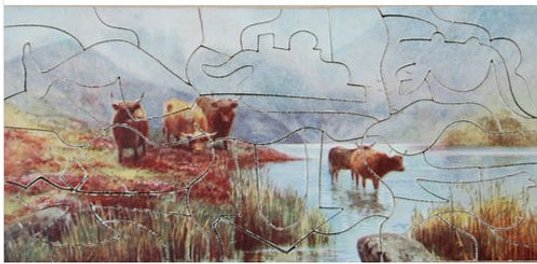

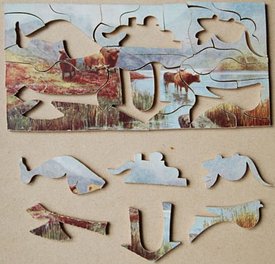
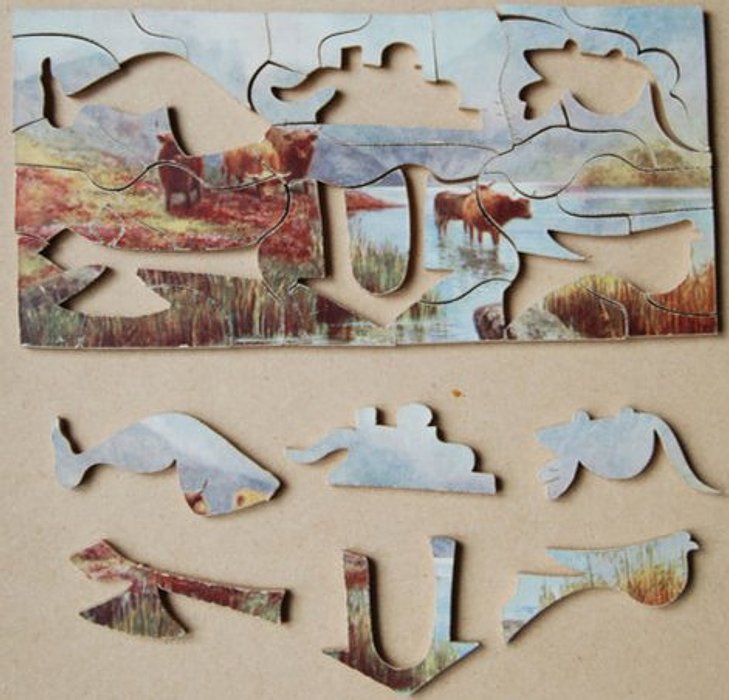
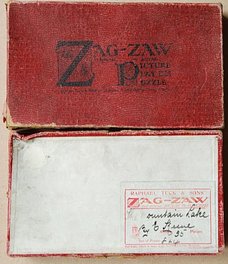
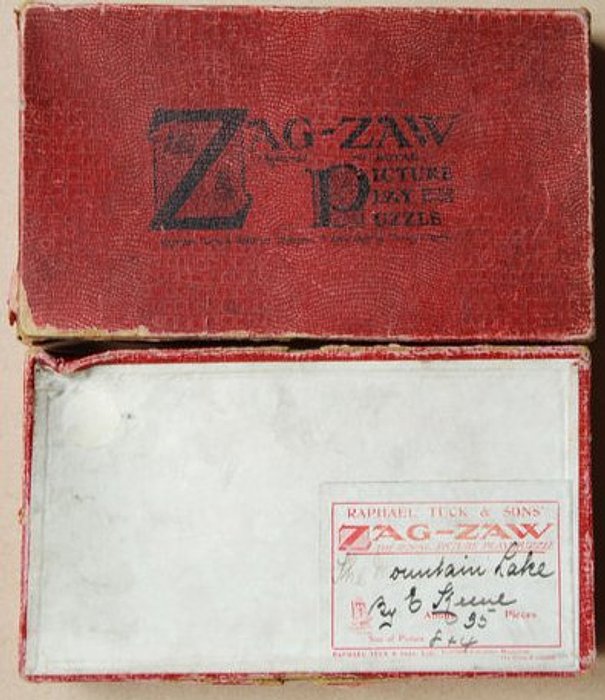
|
35 pieces with several whimsies
|
|
|
|
Zag-Zaw line of puzzles was first produced in 1909, all incorporate figurals or whimsies, sold in red or orange boxes with labels on the side or bottom of the box, most without guide pictures. Initially cut non-interlocking but by 1930's became more so. Puzzles have a different cuts so that the same image will come in several versions which means that missing pieces can not be taken from other puzzles with the same image. See also Bob Armstrong's website on old jigsaw puzzles
|
ELMER KEENE
|
|
8 x 4 in
|
|
|
| |||
| 24917 |
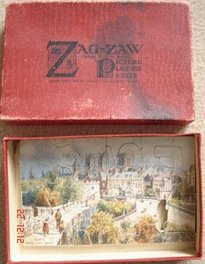
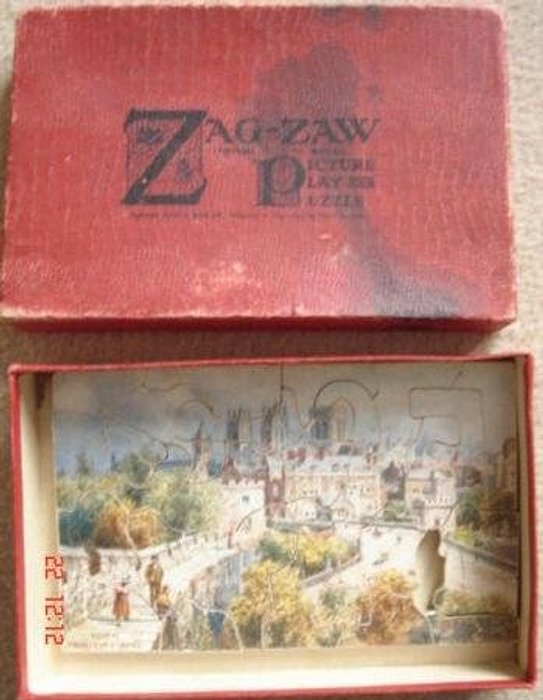
|
title to be confrimed, one piece missing, about 25 pieces
|
|
|
|
Zag-Zaw line of puzzles was first produced in 1909, all incorporate figurals or whimsies, sold in red or orange boxes with labels on the side or bottom of the box, most without guide pictures. Initially cut non-interlocking but by 1930's became more so. Puzzles have a different cuts so that the same image will come in several versions which means that missing pieces can not be taken from other puzzles with the same image. See also Bob Armstrong's website on old jigsaw puzzles
|
|
|
|
|
|
| |||
| 24918 |
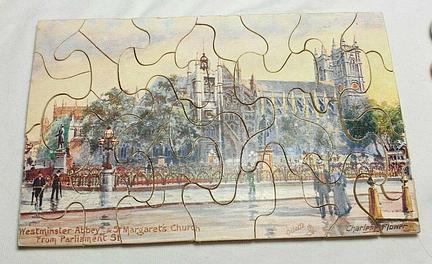
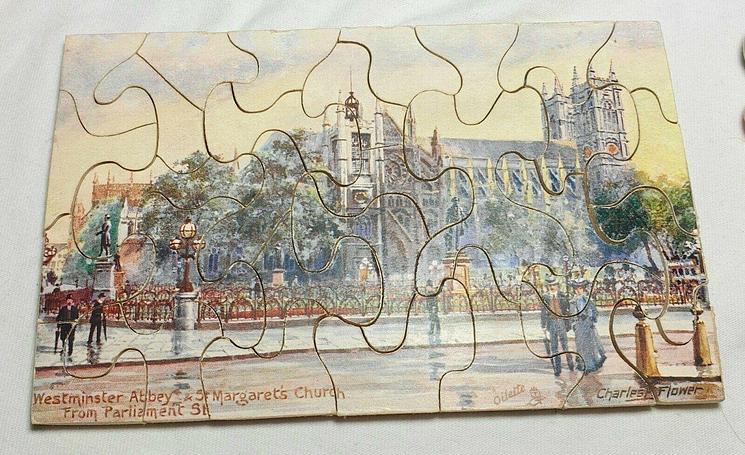
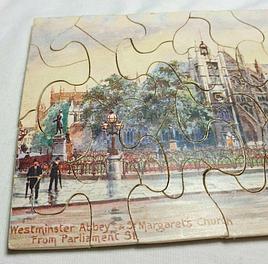
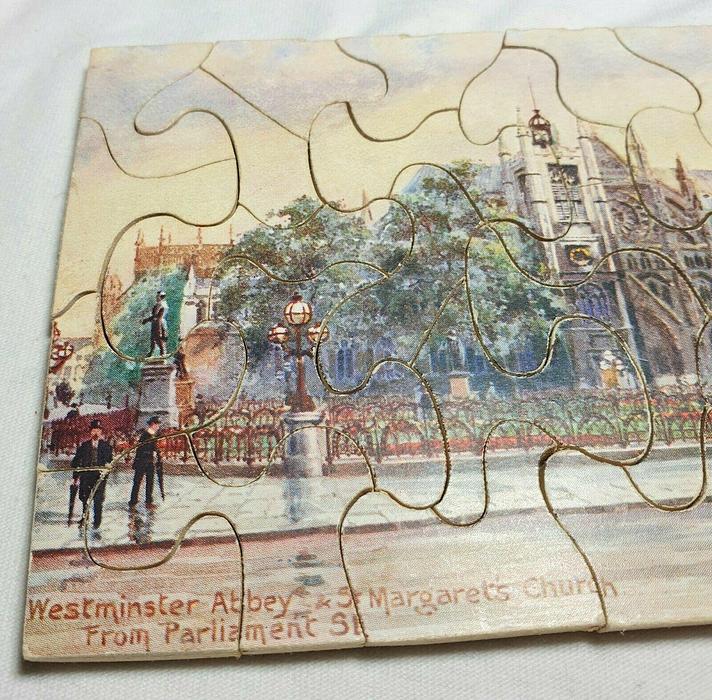
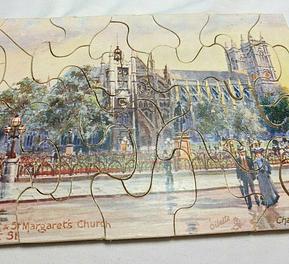
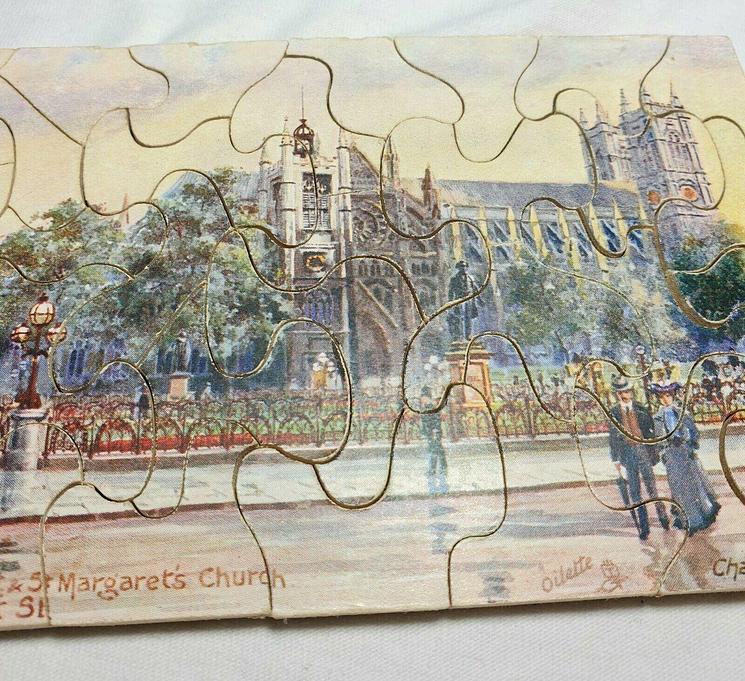
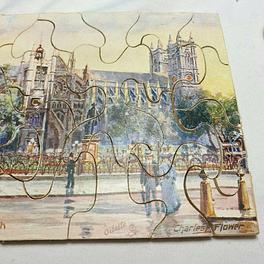

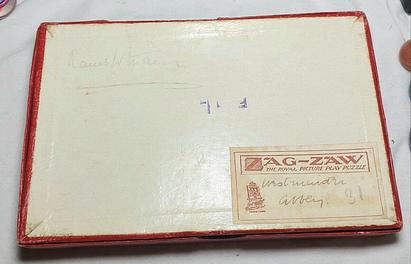
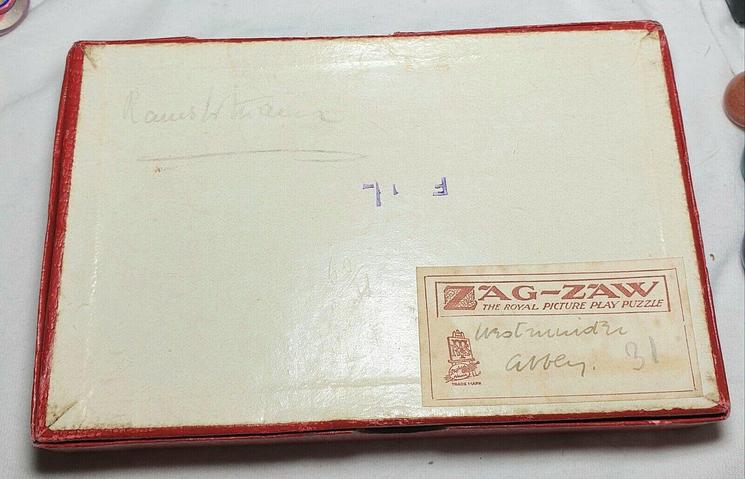
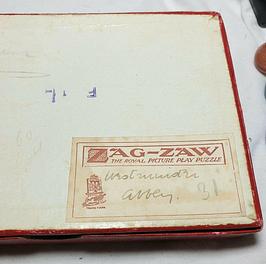
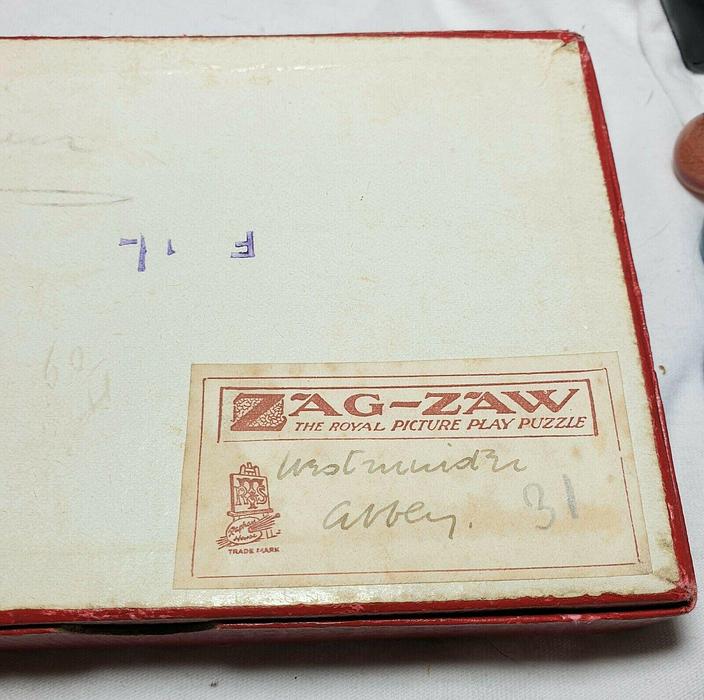
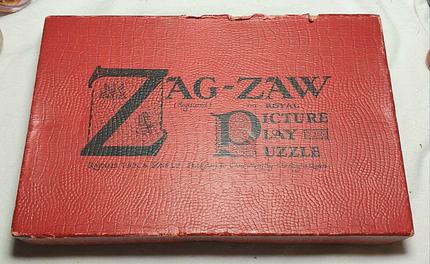
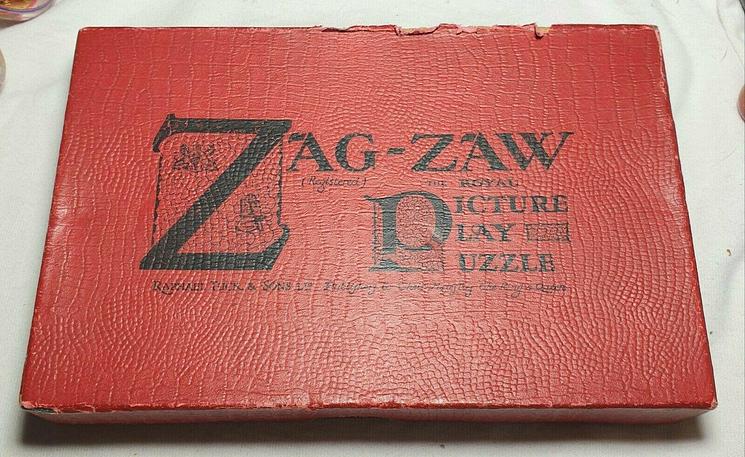
|
31 pieces, wooden, complete with box, push fit style
|
|
|
|
Zag-Zaw line of puzzles was first produced in 1909, most incorporate figurals or whimsies, sold in red, orange, or occasionally green boxes with labels on the side or bottom of the box, most without guide pictures. Initially cut non-interlocking but by 1930's became more so. Puzzles have a different cuts so that the same image will come in several versions which means that missing pieces can not be taken from other puzzles with the same image. The puzzle labels are often hand written and come with minor variations in titles and details. Some have a DESIGN catergory on the label. From my readings this refers to the style of cut, wavy lines, figurals, etc. See also Bob Armstrong's website on old jigsaw puzzles
|
CHARLES FLOWER
|
|
5 1/2 x 3 7/16 in.
|
|
|
| |||
| 24919 |
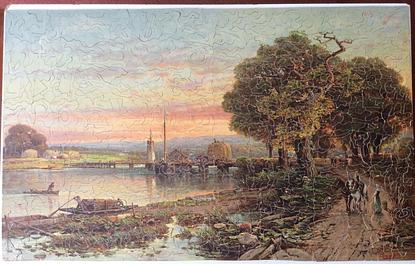


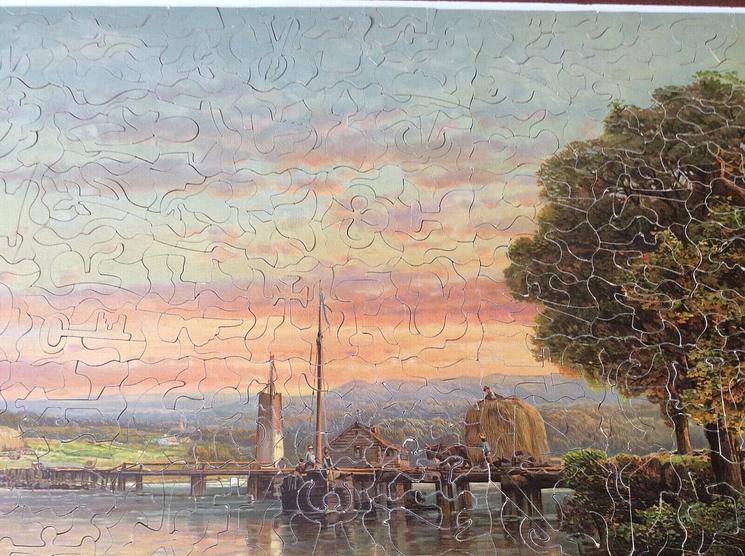
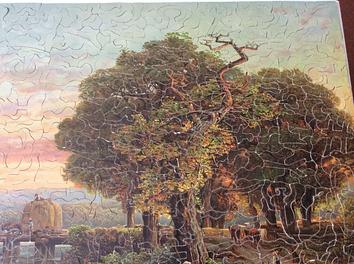
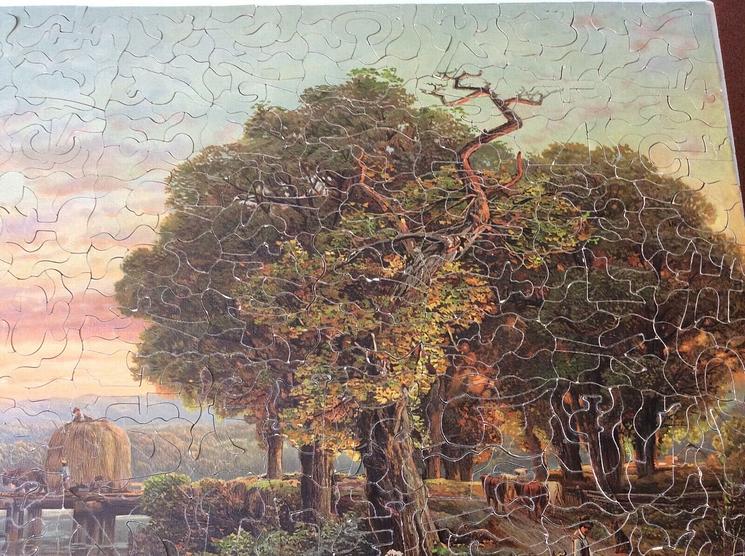

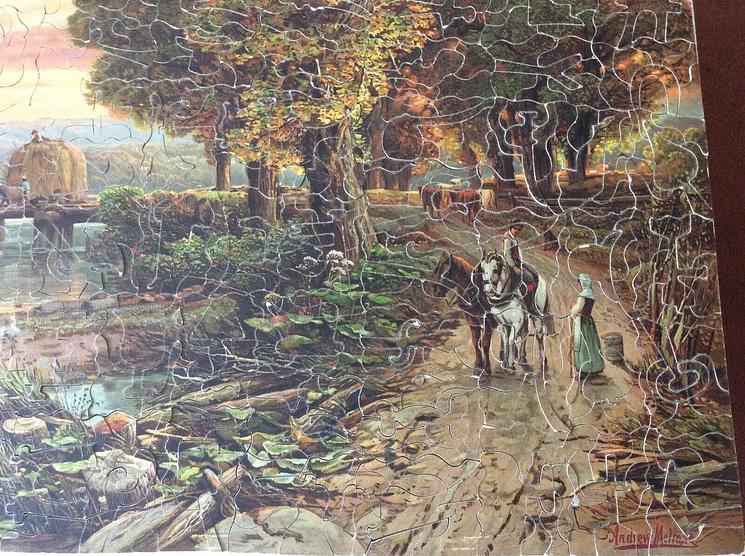
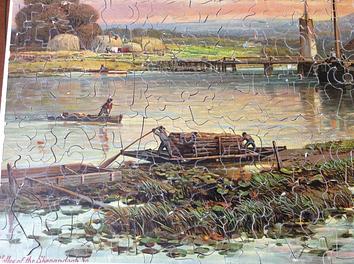
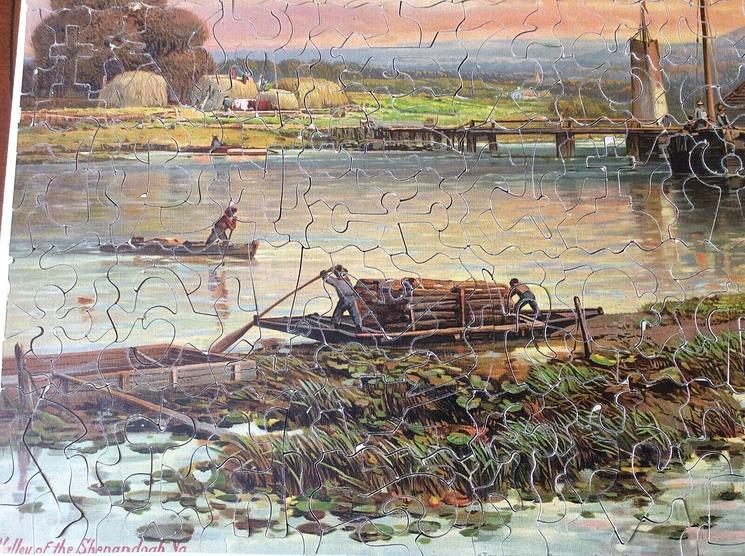
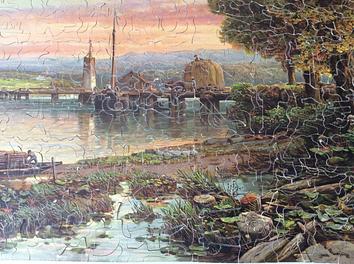
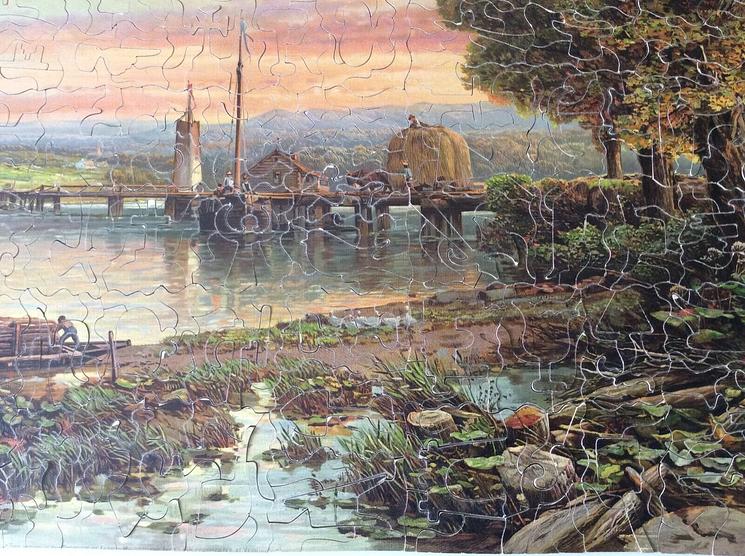
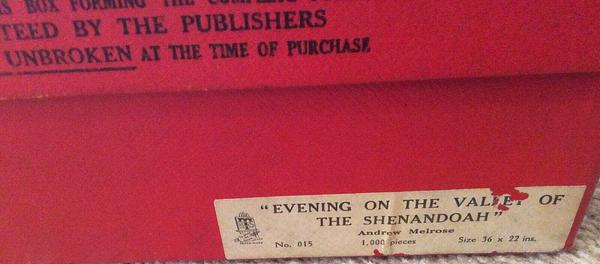

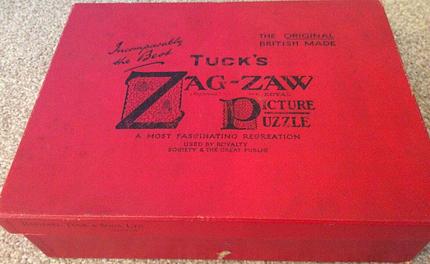
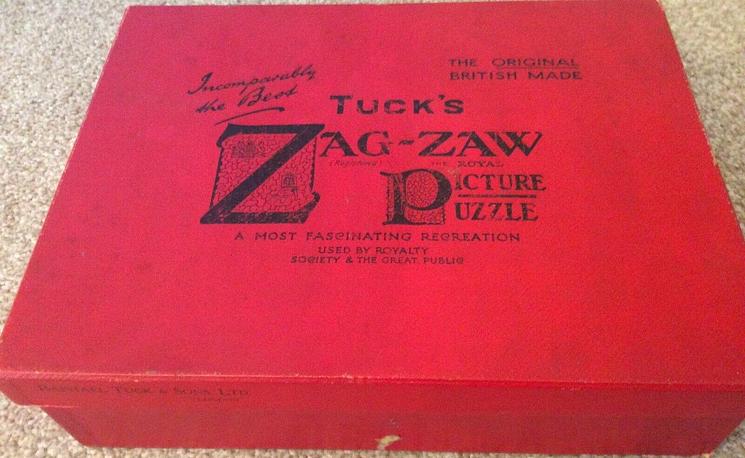
|
1,000 PIECES, also comes as HARRODS puzzle titled THE VALLEY OF THE SHENANDOAH with 1100 pieces, many whimsies
|
|
15
|
|
Zag-Zaw line of puzzles was first produced in 1909, all incorporate figurals or whimsies, sold in red or orange boxes with labels on the side or bottom of the box, most without guide pictures. Initially cut non-interlocking but by 1930's became more so. Puzzles have a different cuts so that the same image will come in several versions which means that missing pieces can not be taken from other puzzles with the same image. See also Bob Armstrong's website on old jigsaw puzzles
|
ANDREW MELROSE
|
|
36 x 22 in.
|
|
|
| |||
| 24920 |
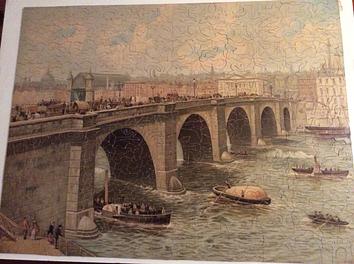
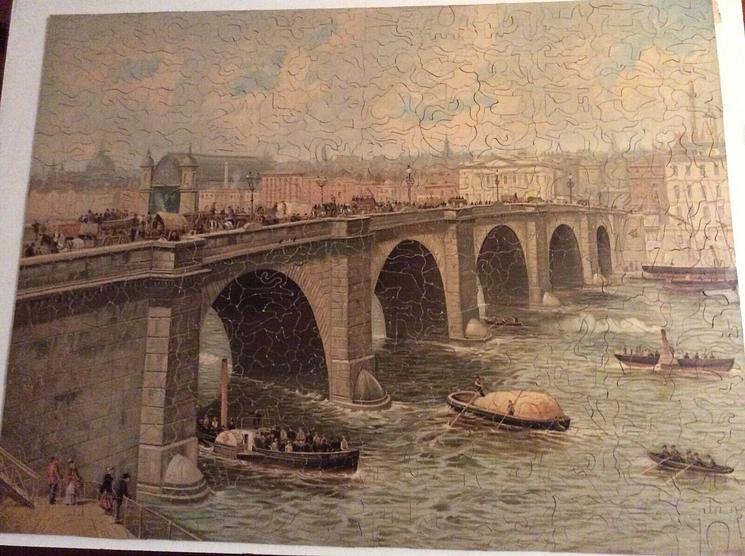
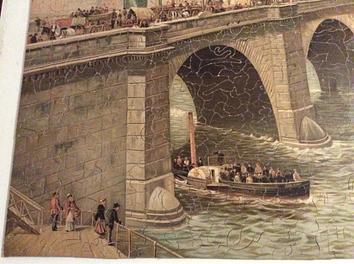
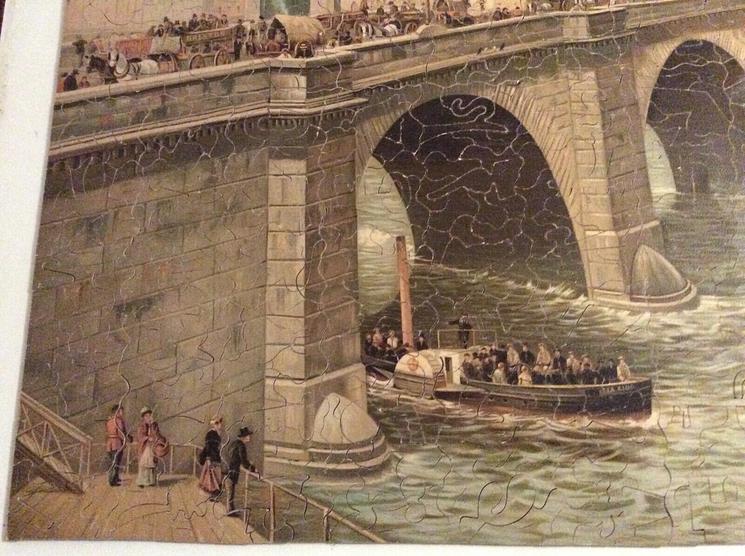

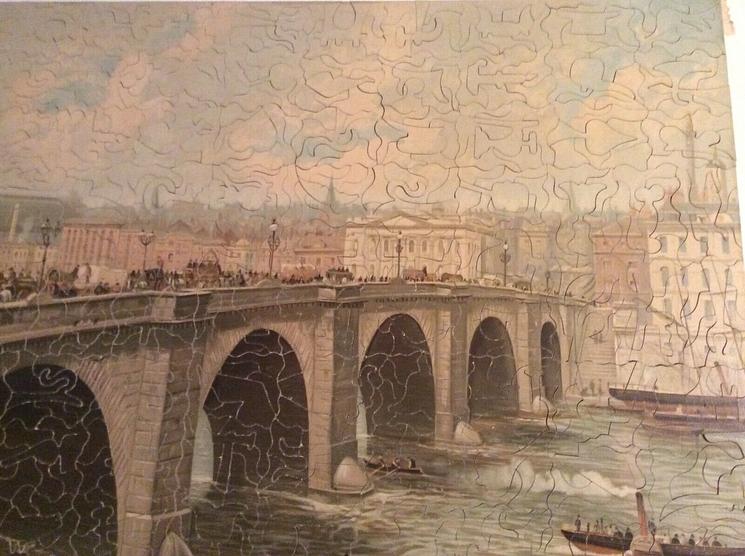

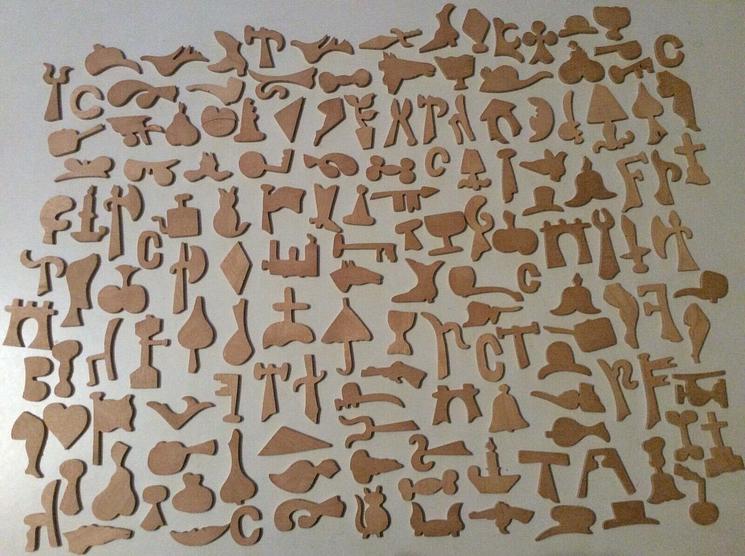



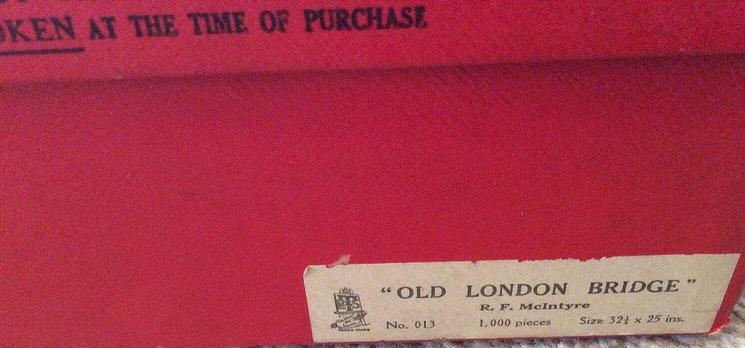
|
dated around 1906, 152 whimsies, complete.
|
|
|
013
|
Zag-Zaw line of puzzles was first produced in 1909, all incorporate figurals or whimsies, sold in red or orange boxes with labels on the side or bottom of the box, most without guide pictures. Initially cut non-interlocking but by 1930's became more so. Puzzles have a different cuts so that the same image will come in several versions which means that missing pieces can not be taken from other puzzles with the same image. See also Bob Armstrong's website on old jigsaw puzzles
|
R. F. MCINTYRE
|
|
32 1/4 x 25 in.
|
|
|
|